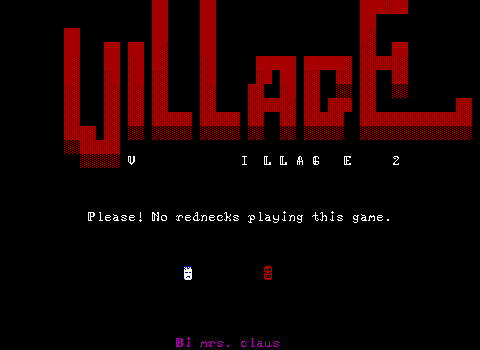The poll winner for... some month (listen my posting schedule has been a disaster lately) is Planets, a game that I had never heard of before, that certainly sounds like something that have some cachet. ZZT has a seemingly endless number of science-fiction worlds set in the far reaches of space, but this one has is unique in a way that surely it should be more well known? Planets is sci-fi, yes, but while that's all over the place, what isn't is the gameplay style. This game is marked as the far more rarely seen strategy genre. Specifically, this is a turn-based strategy game for ZZT!
If you're got a history with ZZT, or have been following along with these articles and streams, maybe the idea of a turn-based strategy game isn't too outlandish these days. ZZT (without enhancements like Weave) has given us Wordle, Sudoku, complex dungeon crawlers, and numerous Preposterous Machines. Maybe, after twenty-some of ZZT's thirty plus years, you can believe somebody was daring enough to try the impossible and found some way to pull it off.
I don't think the modern ZZT community would be all that shocked if WiL, Kkairos, or Lancer X accomplished such a feat. Planets is far from modern though. It is not an impressive brand new release. It's not a passion of love by Commodore from ZZT's quieter years following the decline of z2 in the late 2000s. It doesn't even come from the golden age at the end of the 90s where a huge pool of ZZTers was around to work together and try to one-up one another.
Planets is dated 1996! This predates the ZZT Encyclopedia, a compilation which shared as many tips and tricks as the community could contribute. This is a game whose contemporaries include Pac-Man, a game where the ghosts are lions and the dots are ammo; a heyday of Yoshi worlds; and generally just a lot of worlds where the programming is still mostly straightforward
While plenty of impressive titles for various reasons were lost to time for various reasons, Planets was readily available on z2, and thus likely the ZZT archive before it for decades. How did a game like this end up with no legacy at all? It doesn't make any sense.
At least until it does. While it's still odd that the title never seems to have gotten much attention, it doesn't take long to figure out why this honest-to-goodness, genuine, bona fide, for-realsies strategy game with single and multiplayer modes of play has effectively been covered in a thick layer of dust for all these years. It's time to take a look at Planets and learn what went right and just how much went wrong.

Limits Are Made To Be Broken
I've got memories of being in a free period in middle school and telling a classmate about ZZT. He loved the idea of being able to make their own video games. Like any thirteen year old, he had lots of ideas for video games that he wished were out there, even if that meant making them himself. He asked me about ZZT. Could the player be a giant robot? Could they have a ton of different weapons? Missiles, bombs, rockets, explosives, machine guns, lasers, all the essentials. They'd be needed of course, for his masterpiece. I had to quickly calm down his imagination.
His interest in ZZT was dismissed before the bell rang. For as empowering as ZZT can be to a child that dreams of making video games, it doesn't take long to realize that you really need to keep your expectations in check.
For those that stuck around long enough to become acquainted with those limitations, and design their creations around them, it instead became a form of bragging rights to do what others considered impossible with ZZT. The thirty-some years of worlds out there serve as a record of discovering what ZZT is truly capable of. Each author pushing the boundaries of what ZZT could do via some brilliant new technique or finding a clever way to apply an existing one.
One of the earliest examples, and one that has a direct connection to Planets can be found in Alexis Janson's Mission: Enigma, whose earliest known version dates back to 1993. It's a game in which many of its scenes had a tremendous influence on ZZT games to come. After Mission: Enigma, having your game's title screen double as a lengthy introductory cut-scene became almost mandatory. Its complex object interactions allowed its puzzles to rely on behaviors most ZZTers wouldn't have bothered to code in (like picking up glass shards or using a leaky pipe to fill a bucket by having water droplets fall in). Its climatic final battle took the form of perhaps ZZT's earliest RPG engine.
Most importantly, it included a game-within-a-game in the form of GEMini.

GEMini was played at a certain point against a massive sentient super-computer to convince them to help you out. An engine was created in which both the human player and the game's AI were tasked with moving gems on a hexagonal grid. In 1993, just the "connect four" aspect of the engine was enough to make it an impressive feat of ZZT engineering. To have a computer controlled opponent for the game though, that elevated it to perhaps the most complex code ZZTers had yet seen.
“If you think about how this game was actually programmed, you will certainly start to gape at the screen uttering a droning chant of
"howdidshedothathowdidshedothathowdidshedothathow...". I mean it!” — Chris Kohler
Thanks to DeadPhrog's old backups, we have copies of early ZZT community newsletters known as The NL which can provide some idea of how much a spectacle GEMini was closer to the time of Enigma's release.
Minds were blown. Mouths were gaped.
Planets looks at GEMini and says "I can do better."
Turn-Based Strategy That Feels Mid
The goal of Planets is to blow up the enemy planet before the enemy blows up your own planet. Okay, so the title makes sense at least.
In order to pull this off, you're given a fleet of six ships scattered throughout the star system. Your task is to guide these ships into battle against the enemy's ships, break through their defensive line either by superior maneuvering or by blasting the opposition into scrap metal, and commence orbital lasering. Of course, while you are doing this, the enemy is attempting to do the same to you, requiring your own defenses to be maintained as well lest you get outflanked.
At least, that's how the game reads on paper. Without getting into the specific mechanics, the premise seems solid. Correctly manage your fleet, outplay your opponent, and victory will be yours. Sadly, while the hypothetical allows players to gloss over the many unexplained parts of the process, once you start playing, the flaws quickly become glaringly obvious.
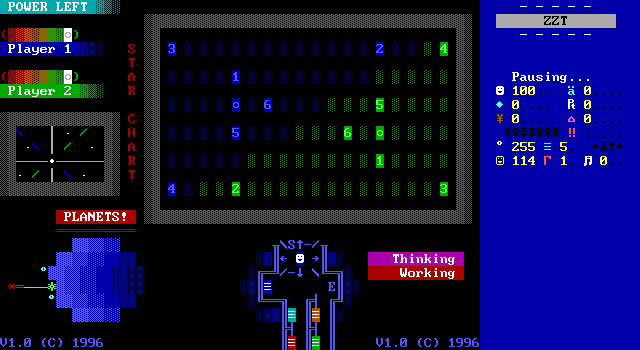
It starts out looking promising. The window dressing ends up being the game's biggest success, making a deceptively simple game appear much more elaborate than it really is.
In the game's single player mode, you're given control of the blue faction. The star chart divides the play area into a grid of 18x6 rectangle of tiles, spread out a bit for ZZT's sake. To extend some kindness to the game, this does help keep the map more legible as well. The human controlled blue faction always goes first, so players move into the large apparatus in the bottom of the screen to begin inputting their commands.
The "S" object is used to choose a ship to take control of. Once a ship has been selected, the arrow objects will become active inputs that directly move the ship you have selected. Provided that you have power left to continue moving.
The power system is probably the first thing about Planets that comes off as an odd decision. The meters in the top left corner of the board show how much power each side has remaining. This meter replenishes automatically after each turn. It is also shared between all your ships. Almost immediately it becomes obvious that the smartest thing to do is to pump all that energy into one ship to get it to reach the enemy's planet in order to attempt to win the game.
From the starting positions, it's possible to move either Ship 2 or Ship 6 into firing position on the enemy planet on your very first turn. Actually winning the game with just a single ship like this would require some impressive levels of luck. In theory though, yes, you could accomplish a one-move checkmate with a single ship, ending the game as soon as it starts.
On subsequent turns you'll still want to move any ship directly to the enemy planet as much as possible. Any leftover power can be used to move the next closest ship and so on.
When you've used all your power, or don't need to move any ships any further, the player needs to head to the "E" object and touch it to confirm that their turn is over. You might think that a more polished game would automatically bring up this prompt once you had no power left. As it turns out, this isn't actually an option since part of what the turn ending object does is traps the player next to it while the engine moves on to the next phase of resolving combat encounters.
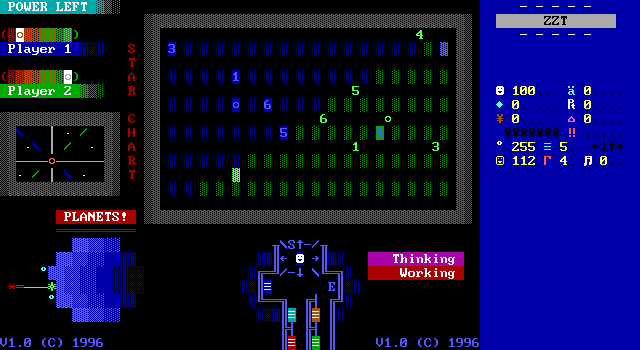
The true reason behind the grid being spaced apart is so that objects can yield themselves out of the way. When a side's turn begins, the opposing side's units all shift to the northeast, keeping the main grid clear so ships can move without potentially bumping into other objects. This makes it so that the computer player doesn't have to worry about finding an alternate route from the one it wants to take. It once again makes it easy to reach the opponent's planet though. You can bypass any potential fights by simply flying on through. It's only if you wind up stopped on a grid cell that should be occupied by an enemy unit that there's actually a battle.
It only occurred to me at the time of writing to see what happens if you try to move into one of your own pieces as they'll all be on the grid together. The answer: an unpleasant tone plays and the move is reverted with no power being consumed.
After one side's turn ends but before the other side can begin, all their off-grid units have to move themselves back on to the grid. This is how Planets detects combat. If a unit is blocked, a flag is set to indicate what piece needs to resolve combat. This is another spot where the game's flaws are clear. Even though the game is correctly detecting what battles need to occur, only a tone plays to indicate combat. No mention is made of which pieces are involved or where to go to handle the encounter.
Instead, players have to enter the correct passage of the four on the bottom of the board to commence combat. By far the most obtuse aspect of the game is remembering which passage is which. I found myself constantly forgetting and entering the incorrect passage. Depending on whose turn it just was, the player will only be able to access two passages so it's not a total free for all. The 2-Player mode has some tight constraints on free board memory available, but even it could at the very least have slapped down some text labels by each passage. In either case, just replacing the doubled-up blue copyright objects would have provided ample room to say "Ship vs Ship - Enter The Yellow Passage" or something.
Making Heads or Tails of Combat
Positioning your ships is just half what Planets offers players. In addition, they need to handle combat scenarios. These are divided into dedicated boards for ship vs. ship and ship vs. planet, with a pair of boards depending on which player is attacking. For ship vs. ship the boards are effectively identical save for the color of the view screen window to indicate which player is on the offense. With ship vs. planet, the surface of each planet is depicted differently, justifying the two-board approach.
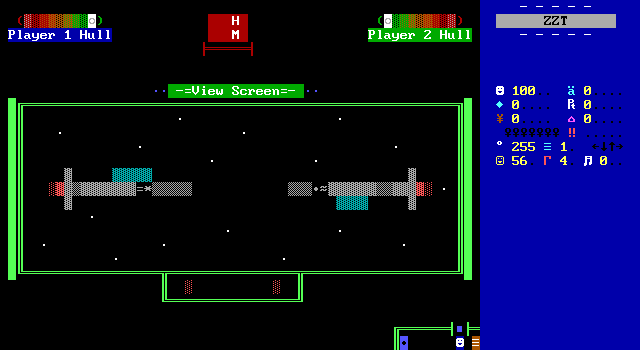
The presentation once more is doing its best to keep the game engaging. The first time you enter one of these boards, the two ships are invisible and pop into view. Strangely, despite the consistent use of STK graphics throughout the world, these ships are built out of standard colored invisible walls, then transformed into sharks and ammo, which are they transformed into the appropriate dark cyan and light gray colors. The end result is indistinguishable from using STK invisibles in the first place, with players tipped off about the use of stock elements to produce these colors thanks to the sound of statted elements (the sharks) being destroyed when they're #changed into walls.
The ships don't hide when combat is over. Even a destroyed ship will appear intact on the view screen after the fight ends. Subsequent entries into these boards will have the ships already visible, so the graphical effect of running into an enemy only really works the first time.
As for the actual fighting, it's a huge letdown. Despite what some of the game's in-universal lore may say, both factions have identical fleets composed of identical ships. All twelve movable units on the board have identical health, offensive capabilities, and move the same way on the star map. This closes off another avenue for potential strategic decisions to be made.
Now, this screen looks like a ZZT RPG engine if I've ever seen one. For a game from 1996 that describes itself as "a breakthrough in ZZT programming", this is still a good opportunity to impress, or at the very least, impress ZZTers back in 1996.
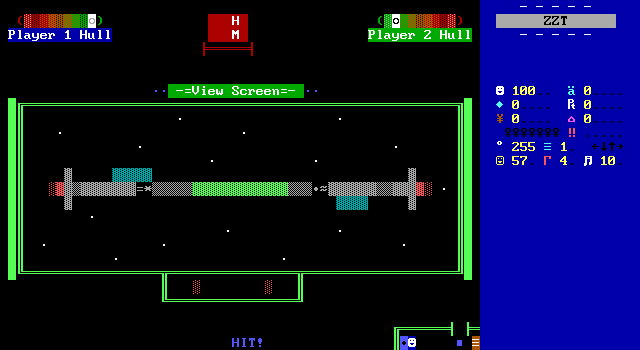
So when I touched the object to initiate combat and wasn't presented with a list of commands I was disappointed.
Combat handling is entirely devoid of player input. The object in the corner serves only to initiate combat. Once the battle has begun, a coin flip determines which faction gets to attack first, with the two alternating from there.
As for the attacks, that too is just a coin flip. Heads you hit. Tails you miss. Hits deal one point of damage to the enemy hull. This continues until one of the ships is destroyed.
Just like the power that resets with each turn, all ship-to-ship combat begins with both sides having an undamaged hull so you can't even pick off a badly damaged ship in an act of revenge.
The presentation is once again the most appealing part of the experience. The ships are a simple design that take turns blasting lasers at each other. These are depicted with visual differences even if the weapons act the same. Player 1 gets a red laser that alternates characters while Player 2 gets a green laser that uses the same character for each tile. Additionally, these weapons have unique sound effects that play when they fire.
The status of each shot is displayed up top with a checkmark appearing next to the H or M letters. The results are repeated via a message on the bottom row. Hits are also indicated by having a new shield being raised in front of the ship after a shot gets through. It's cute stuff, and the sound effects really do a lot to bring you into the battle. Yet with nothing to do but sit and watch, the appeal wears off pretty quickly. These hulls need to be cut in half to keep captains from falling asleep at the helm until a ship explodes.
It is possible for multiple ships to get into combat simultaneously. This gets a bit clumsy with the implementation as well, as you now have to touch the object again to start the second battle once the first is finished. If you didn't happen to notice the need for multiple combat scenarios, you may wind up leaving to the map screen only to still be trapped in your corner and have to run back in.
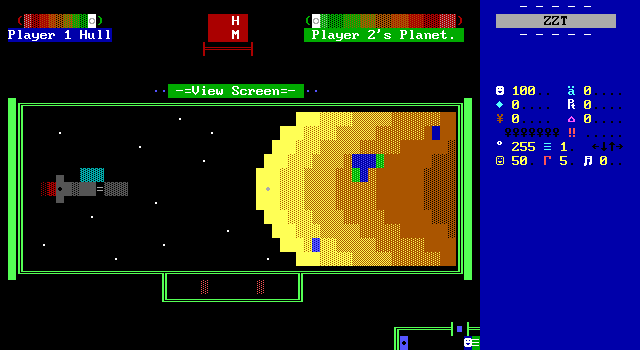
Ship vs Planet combat is basically identical. You get some prettier art since the ship designs are drawn directly to the board rather than made out of invisible walls. The planets differ depending on which is being attacked, with player one defending "Homis Prime", a Earth-like planet covered in water and the CPU/player two on a desert planet known as "Nurim 3". No rationale for the conflict is ever given, though Nurim 3 needing more water and other resources seems like a believable reason for instigation.
In terms of combat, there are only two differences that actually matter here. Firstly, the planets themselves have twice as much health compared to the dinky little ships that attack them. Sucks to be the pilot of the first ship to attack a planet because they're almost certainly not coming home. The other difference is that the planet's health is maintained between fights.
The game continues with each side moving their ships and fighting their fights like this until somebody manages to blow up a planet (or at least blow up enough of it for its populace to surrender). If a faction loses all of their ships, they can do nothing but end their turn. This leaves the possibility of a stalemate where both sides are too injured to defeat a planet eventually leaving both sides devoid of pieces that can try and win, forced into peace by virtue of being unable to make war. You'll really have to go out of your way to engineer such a situation. I don't believe the game has any fail safes to detect such an unlikely scenario.
If this was all there was to say about the engine here, I'd begrudgingly have some respect for it. This is an extreme case of biting off more than ZZT can chew, and doing one's best regardless. It is what it says it is, a turn based strategy game for ZZT. There's no denying that. The problem is, that just like with 4 a few years later, the engine may be clever, but the game attached to it isn't fun.
4 has something going for it that Planets crucially lacks though. Or perhaps it would be better to say 4 lacks something Planets has in abundance. Bugs.
More Bugs Than Starship Troopers
It's not unusual for ZZT engines to be fragile. Even successful games by well-respected authors a few years down the road would still find themselves adding notices to be gentle when it comes to complex code. Planets includes its own disclaimers in the in-game help file as well as its text file, but they don't begin to cover the number of sporadic issues I ran across.
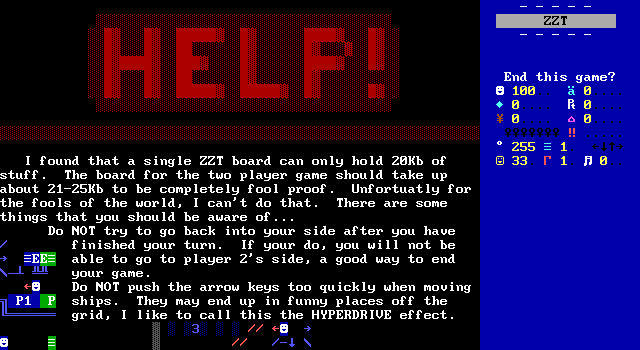
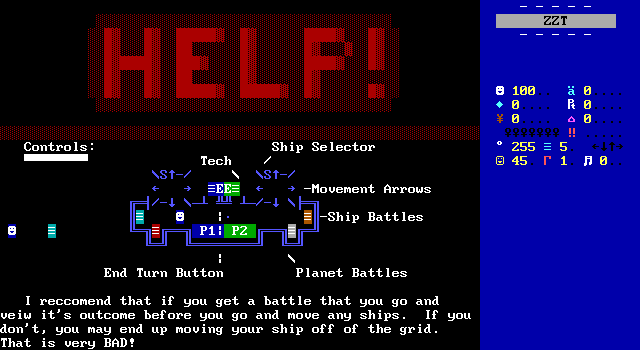
They cover the most common issue. It's not uncommon for at least one of your ships to go off-grid. This shouldn't be a problem to begin with. When an object needs to move, it should lock itself so that the player can't send another input before it reaches the next proper cell. Instead, you have to pace your movements, making everything take just a little bit of extra time. The help file calls this "hyperdrive" as ships affected by the bug don't exist in space. Giving it a nice name to cover up the issues. It's a bit like Robotnik's deadly speed traps (see page 15 of the PDF / 27 of the manual) as a way to try and pass off glitchy behavior as actually perfectly okay.
There is technically an advantage to this, in that by repeating the process a second time in the same or opposite direction, you should be able to get back on the grid. These incomplete moves prevent the ship from telling the power meter to drain, so you could use it to move farther than otherwise allowed.
It has a big disadvantage though in that ending your turn with ship in hyperspace can put it in the path of the CPU. This can send the game state spiraling out of control with enemy ships suddenly finding themselves blocked from completing their own intended move, ending out in hyperspace themselves.
Another common bug is that sometimes a ship would just get erased. Each battle ends with a unique flag for whether or not the ship won or lost, so I'm not sure how the game could wind up confused, but I've definitely had ships just vanish without losing in any encounters.
I've had ships stop responding to input. I've had battles that were supposed to happen be ignored. Everything about Planets is a minefield, waiting for you to blindly step where you shouldn't. For my second game against the CPU, I refused to move my ships at all, wanting to get an idea of how the CPU manages moving its pieces, only to still find the game in a state that required reloading. It gets really bad, and makes squeezing out what enjoyment the game does offer that much harder.
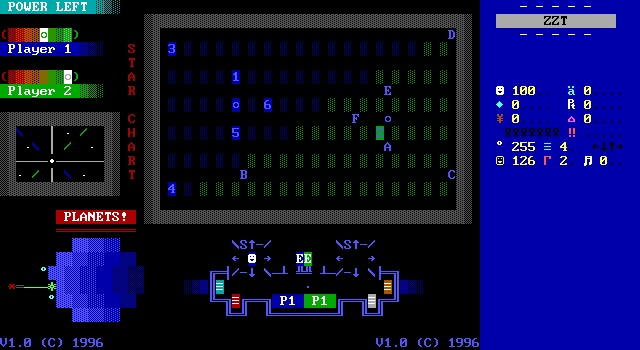
In the 2-Player mode, these issues are even more likely to occur with both players' ships vulnerable to whatever is causing all the bugs that plague Planets. Perhaps as another slight acknowledgment of the issues, there's a tiny gap in the controls that allows you to access any inputs and battle screens regardless of whose turn it actually is.
The Mechanical Turk
Undoubtedly, the first thing anybody would ask after learning about a turn-based strategy game for ZZT is "How?". I've purposely glossed over the way the CPU determines which ships to move and where because by far it's the biggest question about the game. Handling non-human movement is hands down the biggest stumbling block to creating a game like this in ZZT. With all the bugs so far, what does the game do to even suggest that you are playing against a skilled player?
Nothing at all.
I guess it shouldn't be surprising to learn that there isn't a complex system to determine how the enemy moves their ships, but I really didn't expect the specifics to be the most basic approach possible:
#cycle 15
#end
:myturn
#send shipa:l
#send shipb:u
#send shipc:u
#send shipd:l
#send shipe:l
#send shipf:l
#zap myturn
#send yourturn
#end
:myturn
[...]
• • • • • • • • •
It's entirely predetermined. For all the coin flips in combat, there's not even the slightest hint of randomness here. No matter what you do, the computer will always move its ships in the exact same way. All outcomes in this game are based completely on the coin flips of battles.
Even for a hard coded list of turns, the strategy used here is not good! The computer moves all of its ships a single tile every turn, so it takes far longer for enemy ships to reach the player's planet than the other way around. For the computer opponent, the power system is essentially faked, with the CPU actually having it harder. Even the hard coded moves could be improved by splitting them up by ship instead of moving in bulk. Then at least, the game could handle "Ship 4 was destroyed" by using the extra unit of power to play out Ship 5's next move. The current system means that power that would have gone to a destroyed ship intended to move is instead wasted.
Admittedly, it is still rather impressive somehow. I suspect the constant bugs kept this from becoming a well-known part of ZZT history, instead leaving it as an overlooked oddity. Mission: Enigma meanwhile is considered one of the all time greats, hit z2's 10 reviews per file limit decades ago, and has since retained some of the highest review scores around.
GEMini isn't all that different from Planets. Once you get over the surprise that both games offer, the trick is revealed and the reality is far more mundane than the seemingly magic code players aren't looking at when they first place. For GEMini, the AI works as well as it does due to a few factors.
The GEMini playfield is small. Only one piece moves each turn, and it can only more a single tile. With a far smaller move pool available, it's a lot easier for the CPU to blindly guess their way into a smart choice.
The CPU is also given a large advantage over the human player. Its move may be random, but the initial board state puts the CPU's pieces on the inside of the board compared to the player's pieces lining the edges. The CPU can potentially have three pieces lined up after their very first move. Several other moves will still line up two. Due to the layout, even the bad moves are easy to justify to yourself as the CPU playing defensively, working on blocking your own pieces rather than aligning its own.
Play GEMini defensively yourself, and the struggles of the random piece movements utilized by the CPU become obvious.
The large map of Planets, and the ability to move a single piece several spaces in a single turn (combined with the CPU's refusal to do so!) prevent random movements from tricking players. There's no theoretical advantage for a ship to fly in the opposite direction of the enemy planet. Both engines rely on smoke and mirrors to create the illusion of something more complicated than what's really there, with only GEMini's act finding any success in the deception.
Could It Be Salvaged?
Likely the best way to make Planets something to be praised and remembered is to consider not GEMini, but Mission: Enigma as a whole. For all the fuss of that game's fancy engine, the reason it works so well is because it's merely a small part of a larger game. Had Janson simply released a ZZT world called "GEMini", I suspect the reception would have been notably more tepid. When there's this entire game to play, GEMini is a fantastic surprise. Planets instead has to hype itself to players as something more incredible than it is.
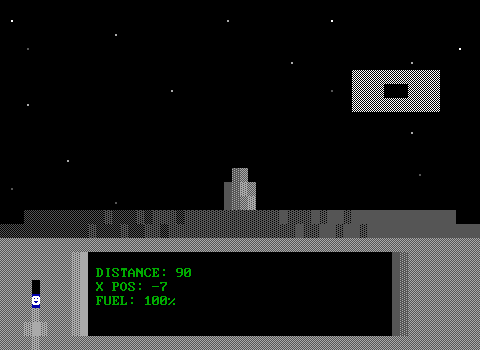
If Planets was an engine used in the middle of a sci-fi adventure, then even entirely unmodified (well, fixing the bugs wouldn't hurt) it could impress so much more. Fixed moves hardly matter when you're going through 40 minutes of gameplay and story beforehand to get to the engine on any playthrough of a more complete adventure. I can imagine something along the lines of Quantum P.'s Operation: GAMMA VELORUM series, where each game in the series offered usually a handful of unique engines to depict in-game events like bombing runs, dogfights, and emergency landings. Though these engines are never billed as the most incredible thing to be written in ZZT, they do a great job of making the games memorable. They only need to be good enough to keep players interested for one brief scene. Entire games made from one of these engines would not be nearly as effective at holding interest.
Of course, it's easy to be an armchair programmer and suggest better managing of moves. When you're only working in theory, memory requirements can't be reasonably inferred and it's easy to imagine something that while it may be better, it wouldn't actually fit in a vanilla ZZT sized board. Oh sure, I'd love for there to be several possible movement pattern "strategies" that the CPU decides it will use at the start of the match, allowing for some slight variation between games, but could that even fit?
I can imagine ships having different stats, giving them advantages or disadvantages in combat based on their opponent. Perhaps a ship that specializes in orbital bombardment that's worth protecting with your other ships as it slowly heads towards the enemy planet. The units could stay on the grid and initiate combat when they bump into an enemy rather than letting players outrun everything by flying through. Allow ships to escape combat, maintaining their hull strength and permitting them to repair themselves over time. Let the ship that initiates the attack get a few free rounds to encourage going on the attack. There needs to be some added complexity somewhere to give players a real decision to make.
Heck, I'd love to just have some options for how to attack enemy ships period. In its current state, you're basically playing a glorified sci-fi version of the card game War. Your only strategic decision is in how to move your ships, and there's so obviously a correct action that it feels like the outcome of the game has already been decided from the outset, with the play element only existing to advance the game state to the next predetermined phase.
Perhaps the easiest fix to make would be to just expand the game with different scenarios. Copy the engine and rearrange the pieces or map a little bit to give players some sense of accomplishment. Different starting positions, different map layouts, whatever you can do to make the game last for more than five minutes.
There are plenty of options that could make Planets a better experience overall. The game right now is just the minimum to say that there's a turn-based strategy game for ZZT. That novelty wears off quickly. There are definitely ways to make it stick around at least long enough to make players want to play a second match.
The STK-Colored Lining
Clearly, Planets has a long way to go to live up to its premise. It's not all bad at least
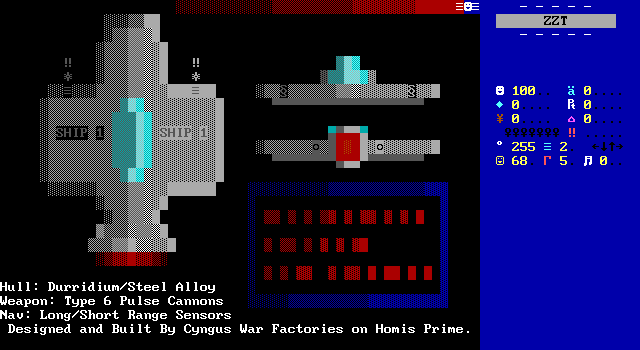
While the engine may do the bare minimum, the author definitely wants this interplanetary conflict to come off as more than just Red Vs. Green. In the single player mode extra passages are included that provide some glimpses at the forces involved in this fighting. Players can get detailed looks at the ships and planets that will be exploding today. Each ship is lovingly drawn in not just an overhead view, but from the front and back as well. Text provides some specifications on the ship's weapon systems and manufacturer.
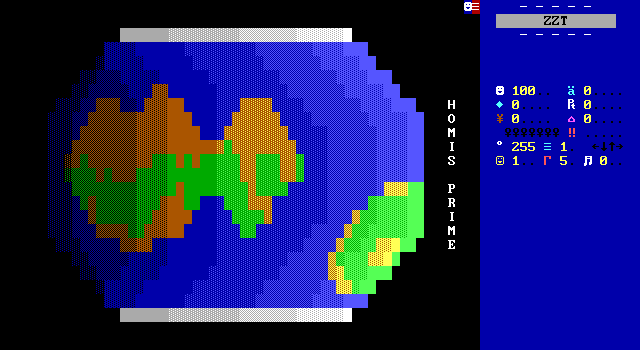
Sure, none of it comes up in the actual game, nor is its information helpful to players, but it offers the one glimpse that Planets didn't want to be an engine and nothing more. It's sci-fi fluff to help establish a mood for the game. Its presence makes me less cynical about the way the game presents itself as a marvel of ZZT-OOP. The author of Planets had more to say than "Look at how good this engine is. I'm the best ZZT programmer around".
And the reality is that while buggy, the engine is indeed novel. It is cool to see a turn-based strategy engine in ZZT, glaring flaws be damned. Your very first game will still feel impressive until something wanders into hyperspace at least. It's another instance of ZZT pulling off something it really shouldn't. ZZTers have an understanding of how difficult creating even a crude facsimile of an existing type of game in ZZT can be. We've been more than happy to applaud those who may not have been able to go all the way, but still managed to go farther than thought possible[1].
The presentation is the best the game has to offer. Combat is improved by the excellent sounds and basic visual effects despite its lack of player input. The little animations, constant sound effects, and depictions of the ships and planets give an otherwise bland engine a chance to be engaging even if the game itself isn't.
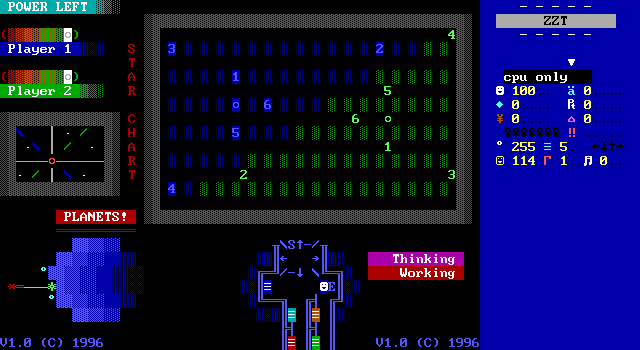
A minor detail wound up being the most impressive thing about the game to me. The one thing that left me thinking that something clever was to be found in Planets is the way that it presents its meters. Every meter in the game is used multiple times over the course of the game as which ship's health meter is being represented changes, and each turn needs to reset the power meter for movement to its maximum value. The only meter that doesn't have a need to reset is the health of each planet.
Creating meters to in ZZT is an old problem with a lot of solutions that all tend to feel slightly off. Even after all these years, the most common approach remains shooting breakable walls. The most common thing to measure with these meters is health, where the exact value doesn't matter, only if the meter is empty or not. There's a downside though in that these meters are a pain to refill if you need to either reuse them or just give more health (or whatever is being measured) before the meter has been depleted.
In Planets, the author just has an object that can be moved west/east to increase/decrease its value. This isn't anything special on its own. What makes it stand out is that these objects are overlaid on top of a pattern of fake walls that fade from green to yellow (brown) to red. The high contrast between the white objects and the dark fakes make it easy to read meters at a glance, and, conveniently, the character used is #10: . This character provides a little window into the background that automatically changes color based on the color of fake wall the object is standing on.
It's so simple, but I can't recall any world ever using fake walls for its meters. It looks nicer than having no background. It's easy to determine whether a meter is low or high. Best of all, it avoids the natural latency added by waiting for bullets to travel down a mostly depleted meter. This system avoids the common situation of a player striking the final blow on an enemy and that enemy having time to attack back before it registers as being defeated. There's no running through the victory passage to the next board while a bullet gets precariously close to hitting an object at the end of the meter that will call #endgame if it's given the chance.
I can't say with too much confidence that Planets is the first game to have implemented this system, but I can say that if it is, then that is what the game's real legacy should be.[2]
Final Thoughts
C for effort?
As a standalone release Planets is a very flawed title. You're provided with a singe player game where the CPU behaves the same every time and a multiplayer variant where the purely random combat prevents players from feeling like there's any way to outplay your opponent. Most games have at least one ship mysteriously vanish or stop responding to input. It's trivial to accidentally break away from the game's grid structure. The CPU plays so poorly that you have to go out of your way to ever see it win. Even then I've had desyncs occur and my planet get knocked off the grid, at which point the CPU can't attack it, eventually exhausting its moves and having an emergency forfeit event decree player one to be the winner from the map screen.
The game really wants to be impressive, but it cannot catch a break from itself. Had it not been such a buggy experience, it still wouldn't be a milestone in ZZT history, but it could at least have made for a fun diversion. There's a tiny hint of something better here, some way to incorporate this into a game that's more than just these two forms of combat. Turn this into a set piece in a more story and gameplay rich game and it would land so much better. Instead, the specific decisions with how to implement CPU movement quickly eliminate the "wow" factor. Players are left bored, spaceships are left drifting in hyperspace, and planets avoid their Earth shattering kabooms.
If you want a ZZT turn based strategy that works, you're still going to have to make it yourself. I'm certainly no stranger to making ZZT engines where the fun goes to the author creating them as a personal challenge more than the players playing them. Planets seems much more interested in appealing to the players. It's a much more noble goal, that's a heck of a lot harder to pull off. So far, nobody's managed to do it. Frankly, I don't think it can be done in vanilla ZZT. But I've been wrong before...
- [1] ZZTris being the perfect example. It's Tetris for ZZT! Just ignore the fact that the pieces are triominoes and not tetrominoes. Or perhaps, Z*Bert for some non-isometric Q*Bert arcade action.
- [2] What may be it's other first is that this game specifically cites ZZT's board limit correctly as 20,000 bytes. Knowledge which at the time was likely discovered in a very frustrating way. Where and when this information was first documented has always been a mystery, and I believe right now this is the earliest such reference I've seen.

